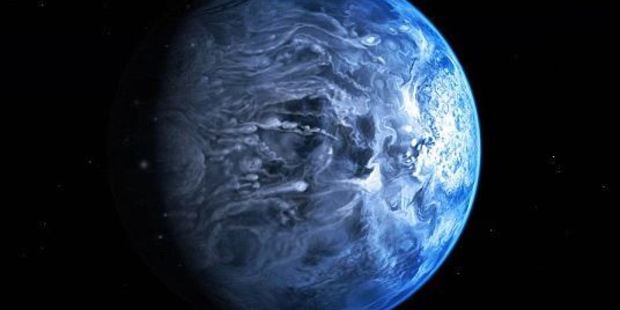
Nasa reveals ‘nightmare planet’ with ‘worst weather in universe’ including 5000mph winds and 3000C temperatures.
“The nightmare world of HD 189733 b is the killer you never see coming,” said Nasa.
“To the human eye, this far-off planet looks bright blue,” the space agency says.
“But any space traveler confusing it with the friendly skies of Earth would be badly mistaken.
“The weather on this world is deadly.”
Researchers have calculated that its winds blow up to 5,400 mph (2 km/s) at seven times the speed of sound – instantly whipping all would-be travellers into a sickening spiral around the planet.
However, that pales into insignificance compared to the rain, which Nasa describes as “death by a thousand cuts.”
“The explanet possibly rains glass-sideways-in its howling winds,” the space agency claims.
Even its calm blue colour hides a secret – the cobalt blue comes not from the reflection of a tropical ocean, as on Earth, but rather a hazy, blow-torched atmosphere containing high clouds laced with silicate particles.
Last year scientists were able to first study the weather, just by measuring sodium emissions from the exoplanet.
The findings – made with a relatively small telescope – suggest we may soon have the opportunity to examine other distant worlds beyond the solar system in unprecedented detail.
The research was carried out by scientists from the Universities of Geneva and Bern in Switzerland.
HD 189733b is a gas-giant slightly larger than Jupiter located 370 trillion miles (600 trillion km) from Earth – or 63 light-years.
It is located in the constellation Vulpecula in the night sky – also known as the “little fox.”
The scientists found that the temperature on the planet increases dramatically with altitude – up to 3,000°C in the upper atmosphere, hot enough to melt lead.
Coupled with the extremely high wind speed of 1,000km/h, it reveals the planet has an extremely turbulent atmosphere – and is almost certainly inhospitable to life.
The planet was already known to orbit 13 times closer to its star that Mercury is to our sun, completing an orbit in just 2.2 days.
But the results are exciting, because it highlights just how much information we can glean from a distant world with limited technologies.
Speaking to MailOnline, subproject leader Dr Kevin Heng said it could be possible to measure the conditions on an Earth-like world using this technique – although the process was difficult.
“It remains to be seen if the astronomical community is able to do these measurements for Earth analogues,” he said.
The difficulty arises because an Earth-sized world blocks out much less of the light of its parent star compared to a Jupiter-sized world like HD 189733 b.
“It would help if we can find an Earth-like exoplanet orbiting a really bright star,” Dr Heng added.
And he said the research was important because they used a “dinky four-metre telescope from the ground to do measurements of the quality as the Hubble Space Telescope.”
The technique works by measuring the ‘sodium signal’ from distant worlds. When a planet passes in front of its star, the intensity of this signal varies.
Depending on how weak or strong the signal is, it is possible to work out how hot the planet is.
And because the signals come from different altitudes, the scientists can measure the temperature difference across the atmosphere.
Lower down on the planet, temperatures are believed to drop to a still-scorching 1,700°C.
To measure the wind, the team measured how the sodium lines were ‘blueshifted’ – meaning its light was stretched in such a way to indicate it was coming towards us.
And this blueshift suggests winds are coming from a circulation process on the planet – or, in other words, superfast winds.
Comparable measurements of this planet have been made before, using large ground-based telescope (with mirrors up to 10 metres in size) and the Hubble Space Telescope.
But this research used a comparatively small telescope, just 3.6 metres wide, at the European Southern Observatory (ESO) in La Silla, Chile.
The research opens up the opportunity of studying atmospheres of distant exoplanets without having to resort to giant observatories or space telescopes.














If the temperature reaches 5000C… then how the hell is there any water on it for it to rain???
It doesn’t rain water Brian, it rains silicate particles but you would have known that if you actually read the article you imbecile.